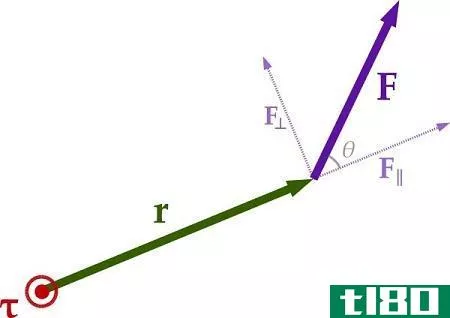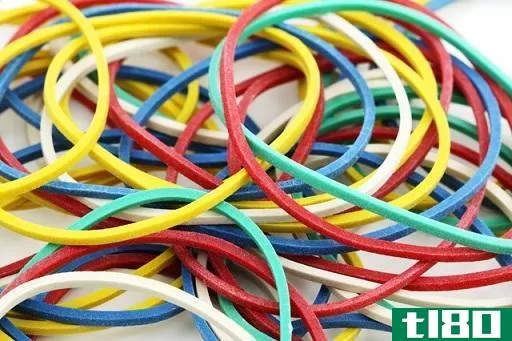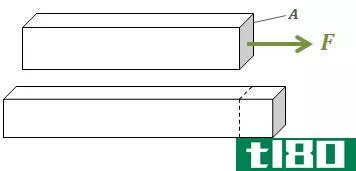弹性模量(modulus of elasticity)和刚度模数(modulus of rigidity)的区别
主要区别-弹性模量与刚性模量
弹性模量和刚度模量是材料工程师用来描述材料如何变形的两个数字。弹性模量和刚度模量之间的主要区别在于,弹性模量描述了当力以直角施加于物体表面时,材料是如何变形的,使材料拉长或缩短,而刚性模量描述了当平行于物体表面施加力时,材料如何变形,从而导致其中一个表面相对于同一物体的另一个表面发生移动。
什么是弹性模量(the modulus of elasticity)?
Modulus of elasticity (Young modulus) is a number that describes the ratio of stress to strain in an object that is being deformed by a force that is perpendicular to a surface of an object. The stress of a material is the deforming force per unit area. For instance, the figure below shows an object that becomes elongated as a result of a tensile force on it. In this case, the stress ( ) is given by:
由于变形力与物体表面成直角,所以这种应力通常称为法向应力。
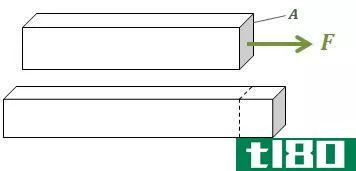
Tensile stress from a force acting at right angles to a surface.
The strain is the fractional change in length of the object. Suppose the object had a length before the deforming force acted on it, and if the object gets elongated by a length under the deforming force, then the strain ( ) is given by:
The modulus of elasticity ( ) is then given by:
什么是刚度模量(the modulus of rigidity)?
刚度模量(剪切模量)是一个给出单位面积作用在材料上的剪切应力的数字。在这里,变形力平行于物体的一个面,导致一个面相对于另一个面发生位移。其描述如下:
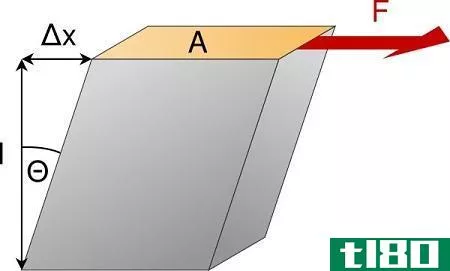
Shear stress from a force parallel to the surface.
So, shear stress () is given as:
这个方程与法向应力方程的形式相同,不同之处在于力的作用方式。
The shear strain () is defined as the ratio of relative displacement between the surfaces to the separation between the surfaces. Here,
Once again the shear modulus () is the ratio between shear stress and shear strain:
弹性模量与刚度模量的关系
Modulus of elasticity ( ) and the modulus of rigidity ( ) are related by the following equation:
Here, represents a number called Poisson’s ratio given to the particular material. When the material is being stretched in one direction, it gets shortened in a perpendicular direction. In the direction that the material becomes elongated, the axial strain () is defined as the fractional increase in the length. In the direction that the material shortens, the transverse strain () gives the fractional reduction in length. The diagram below illustrates these changes in shape:

Defining Poisson’s ratio
在该图中,轴向应变为:
横向应变为:
Note that since the object shortens in the directiopn perpendicular to the force, . Poisson’s ratio ( ) is defined as:
The minus sign has been introduced to ensure that takes a positive value.
弹性模量(modulus of elasticity)和刚度模数(modulus of rigidity)的区别
力的方向
弹性模量用于计算变形力与物体表面成直角时物体的变形。
刚度模量用于计算变形力平行于物体表面时的变形。
形状变化
在计算弹性模量时,物体在变形力作用下要么变长要么变短。
在计算刚度模量时,物体的一个表面相对于另一个表面发生位移。
相对大小
对于大多数材料,弹性模量大于刚度模量。这一规则的例外是具有负泊松比的所谓“auxetic”材料,但这些材料不太常见。
- 发表于 2021-06-27 08:23
- 阅读 ( 148 )
- 分类:科学
你可能感兴趣的文章
硬度(hardness)和韧性(toughness)的区别
...伤软的材料。硬度取决于其他材料特性,如延展性、弹性刚度、塑性、应变、强度、韧性和粘度。钻石是地球上最坚硬的天然材料。其他硬质材料的例子是陶瓷、混凝土和一些金属。 韧性:坚韧的材料可以吸收大量的能量而不...
- 发布于 2020-10-28 17:30
- 阅读 ( 603 )
痉挛(spasticity)和刚性(rigidity)的区别
...拉伸反射的兴奋性,它表现出异常高的肌肉张力。 刚性 刚度与运动速度无关。在这种情况下,关节的阻力不受肌肉运动速度的影响。 4) 痉挛和僵硬病变 痉挛 在锥体束病变(上运动神经元病变)中发现痉挛。 刚性 在锥体外系...
- 发布于 2021-06-25 05:24
- 阅读 ( 340 )
有弹力的(elastic)和非弹性碰撞(inelastic collision)的区别
主要区别-弹性与非弹性碰撞 碰撞可以分为弹性碰撞和非弹性碰撞。弹性碰撞和非弹性碰撞的主要区别在于,在弹性碰撞中,碰撞前物体的总动能等于碰撞后物体的总动能。在非弹性碰撞中,碰撞后物体的总动能小于碰撞...
- 发布于 2021-06-27 03:54
- 阅读 ( 569 )
扭矩(torque)和扭转(torsion)的区别
...t, is the quantity known as “torsion c***tant“, and is the shear modulus of the material. 扭矩(torque)和扭转(torsion)的区别 它描述了什么 转矩是能够产生角加速度的东西。 扭转是由于扭转而产生的扭转。 Image Courtesy “A force is applied to a par...
- 发布于 2021-06-27 05:26
- 阅读 ( 676 )
重力势能(gravitational potential energy)和弹性势能(elastic potential energy)的区别
主要区别-重力势能与弹性势能 重力势能和弹性势能是粒子能具有的两种不同形式的能量。引力势能和弹性势能的主要区别在于,引力势能的来源是作用在两个大质量物体之间的引力,而弹性势能的来源是组成物质的分子...
- 发布于 2021-06-27 07:33
- 阅读 ( 779 )
剪切应力(shear stress)和拉应力(tensile stress)的区别
... ( ) as a fraction of the original length ( ): A quantity called Young modulus ( ) describes how relatively difficult it is to stretch a given material. This quantity is defined as: 什么是剪切应力(shear stress)? 剪切应力是指变形力平行于表面的情况。如果相对表面...
- 发布于 2021-06-27 08:20
- 阅读 ( 1464 )
区分需求的价格弹性和收入弹性
主要差价弹性(main difference price elasticity) vs. 收入需求弹性(income elasticity of demand) 弹性是经济学中广泛使用的一种常用指标,涉及价格、收入、相关商品和服务的价格等不同参数。弹性可以定义为数量(需求/供给)对自...
- 发布于 2021-06-28 06:17
- 阅读 ( 609 )
有弹力的(elastic)和肌动脉(muscular arteries)的区别
弹性动脉和肌肉动脉的主要区别在于,弹性动脉最靠近心脏,当心脏迫使血液进入弹性动脉时,弹性动脉承受巨大的压力,而肌肉动脉负责将血液输送到体内不同类型的**。弹性动脉中膜主要由弹性蛋白组成,肌动脉中膜主要由...
- 发布于 2021-07-01 14:47
- 阅读 ( 228 )
痉挛(spasticity)和刚性(rigidity)的区别
...它是由于锥体外系病变,如帕金森病。此外,它的特点是刚度大,不灵活,不能弯曲、扭曲或拉伸。最重要的是,肌肉紧张和僵硬是僵硬的主要特征。此外,刚度是双向的。因此,它可以导致所有方向的运动僵硬。此外,它不依...
- 发布于 2021-07-01 23:47
- 阅读 ( 335 )
什么是剪切模量?(the shear modulus?)
...形线性阻力的度量。剪切模量、杨氏模量和体积模量均为弹性模量,均基于胡克定律,并通过方程相互连接。 来源 克兰德尔,达尔,拉德纳(1959)。固体力学导论。波士顿:麦格劳·希尔。ISBN 0-07-013441-3。 Guinan,M;斯坦...
- 发布于 2021-09-10 07:04
- 阅读 ( 407 )



